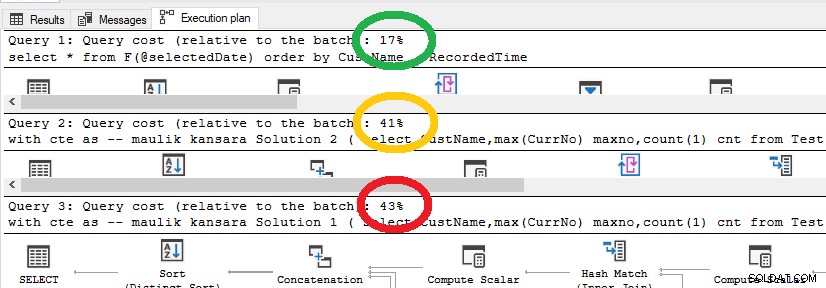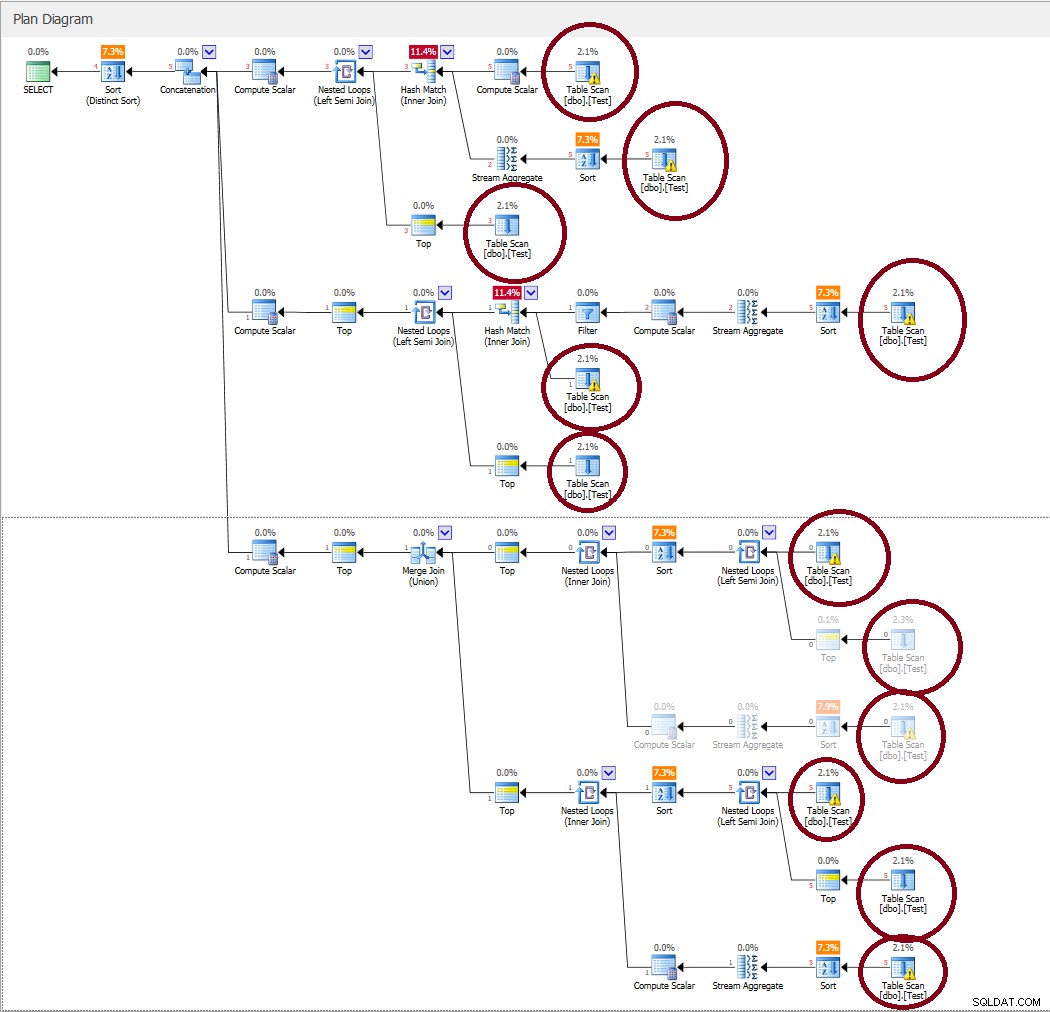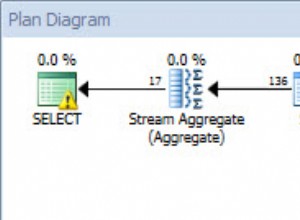Buona giornata,
Si prega di verificare se la soluzione seguente risolve tutte le vostre esigenze. L'ho testato con i tuoi dati e con alcune righe in più, ma è sempre meglio ricontrollare. A prima vista sembra che restituisca il risultato richiesto. Aggiungerò qualche spiegazione più avanti
La query che sto usando questo:
DECLARE @Date DATE = '2018-06-12';
with MyCTE as (
SELECT
t.CustName,t.Country,t.RecordedTime,t.CurrNo, D = CONVERT(DATE, RecordedTime)
,RN_D = ROW_NUMBER()
OVER (partition by t.CustName order by t.CurrNo desc)
,RN = ROW_NUMBER()
OVER (partition by t.CustName order by t.CurrNo)
,RN_Old = ROW_NUMBER()
OVER (partition by t.CustName, (CASE WHEN CONVERT(DATE, RecordedTime) < @Date then 0 else 1 END) order by t.CurrNo desc)
,Cnt = COUNT(*)
OVER (partition by t.CustName)
,CntToday = COUNT(CASE WHEN CONVERT(DATE, RecordedTime) = @Date THEN 1 ELSE NULL END)
OVER (partition by t.CustName)
FROM Test t
where
-- returns rows untill current date
CONVERT (DATE, RecordedTime) <= @Date
-- only if relevnat to current date
and EXISTS (
SELECT * FROM test t0
where CONVERT (DATE, RecordedTime) = @Date and t0.CustName = t.CustName
)
)
,MyCTE2 as (
select
CustName, Country, RecordedTime, D, CurrNo, RN_D, RN, Cnt, t2.c, History, CntToday, RN_Old
from MyCTE t1
left JOIN (select * from (values(1, 'NEW'),(1, 'BEFORE')) t2(c, History) ) t2
on t1.CurrNo = t2.c
and CntToday > 1
and D = @Date
where
RN_D = 1
or (RN = 1 and D = @Date)
or (RN_Old = 1 and D < @Date)
)
,MyCTE3 as (
select CustName, Country, RecordedTime
-- unmarke the bellow comment in order to get the accessories columns I used
-- This is recommended to understand the line-of-thinking
--, D, c, RN_D, RN, CurrNo, Cnt, CntToday, RN_Old
, History = CASE
WHEN CurrNo = 1 and Cnt = 1 then 'NEW'
WHEN RN_D = 1 then 'CURRENT'
else ISNULL(History,'BEFORE')
END
from MyCTE2
)
select CustName, Country, RecordedTime--, D, c, RN_D, RN, CurrNo, Cnt, CntToday, RN_Old
,Audit = CASE when History='New' then 'ADD' else 'CHANGE' END
, History
from MyCTE3
Per semplificare il test, inserisco l'intera query nella funzione tabella
DROP FUNCTION IF EXISTS dbo.F
GO
CREATE FUNCTION dbo.F(@Date DATE)
RETURNS TABLE AS RETURN (
--DECLARE @Date DATE = '2018-06-12';
with MyCTE as (
SELECT
t.CustName,t.Country,t.RecordedTime,t.CurrNo, D = CONVERT(DATE, RecordedTime)
,RN_D = ROW_NUMBER()
OVER (partition by t.CustName order by t.CurrNo desc)
,RN = ROW_NUMBER()
OVER (partition by t.CustName order by t.CurrNo)
,RN_Old = ROW_NUMBER()
OVER (partition by t.CustName, (CASE WHEN CONVERT(DATE, RecordedTime) < @Date then 0 else 1 END) order by t.CurrNo desc)
,Cnt = COUNT(*)
OVER (partition by t.CustName)
,CntToday = COUNT(CASE WHEN CONVERT(DATE, RecordedTime) = @Date THEN 1 ELSE NULL END)
OVER (partition by t.CustName)
FROM Test t
where
-- returns rows untill current date
CONVERT (DATE, RecordedTime) <= @Date
-- only if relevnat to current date
and EXISTS (
SELECT * FROM test t0
where CONVERT (DATE, RecordedTime) = @Date and t0.CustName = t.CustName
)
)
,MyCTE2 as (
select
CustName, Country, RecordedTime, D, CurrNo, RN_D, RN, Cnt, t2.c, History, CntToday, RN_Old
from MyCTE t1
left JOIN (select * from (values(1, 'NEW'),(1, 'BEFORE')) t2(c, History) ) t2
on t1.CurrNo = t2.c
and CntToday > 1
and D = @Date
where
RN_D = 1
or (RN = 1 and D = @Date)
or (RN_Old = 1 and D < @Date)
)
,MyCTE3 as (
select CustName, Country, RecordedTime
-- unmarke the bellow comment in order to get the accessories columns I used
-- This is recommended to understand the line-of-thinking
--, D, c, RN_D, RN, CurrNo, Cnt, CntToday, RN_Old
, History = CASE
WHEN CurrNo = 1 and Cnt = 1 then 'NEW'
WHEN RN_D = 1 then 'CURRENT'
else ISNULL(History,'BEFORE')
END
from MyCTE2
)
select CustName, Country, RecordedTime--, D, c, RN_D, RN, CurrNo, Cnt, CntToday, RN_Old
,Audit = CASE when History='New' then 'ADD' else 'CHANGE' END
, History
from MyCTE3
--order by CustName, RecordedTime
)
GO
Utilizzando la funzione è più semplice effettuare test multipli, ma probabilmente in produzione vorrai utilizzare la query diretta
-- Test
select * from F('2018-06-01') order by CustName , RecordedTime
select * from F('2018-06-02') order by CustName , RecordedTime
select * from F('2018-06-03') order by CustName , RecordedTime
select * from F('2018-06-10') order by CustName , RecordedTime
select * from F('2018-06-11') order by CustName , RecordedTime
select * from F('2018-06-12') order by CustName , RecordedTime
select * from F('2018-06-13') order by CustName , RecordedTime
select * from F('2018-06-14') order by CustName , RecordedTime
/**************** Aggiornamento al 19-08-2018 14:05 ora di Israele ****************/
Ho notato che alcune informazioni in più sono importanti da aggiungere per il bene della partecipazione al thread. Spero che questo sarà utile
Innanzitutto, confrontiamo la percentuale di utilizzo delle risorse in base ai piani di esecuzione di tre query:(1) La mia soluzione, (2) maulik kansara seconda soluzione dopo l'aggiornamento della prima soluzione e (3) maulik kansara prima soluzione
Ora controlliamo l'immagine della soluzione EP di maulik kansara secondi:
Questa query esegue la scansione della tabella 11 volte!






